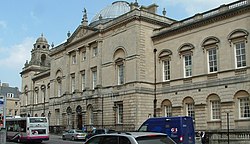Guildhall, Bath
| The Guildhall | |
|---|---|
 |
|
| Location | Bath, Somerset, England |
| Coordinates | 51°22′55″N 2°21′32″W / 51.38194°N 2.35889°WCoordinates: 51°22′55″N 2°21′32″W / 51.38194°N 2.35889°W |
| Built | 1775 |
| Architect | Thomas Baldwin |
|
Listed Building – Grade I
|
|
| Designated | 12 June, 1950 |
| Reference no. | 442118 |
The Guildhall in Bath, Somerset, England was built between 1775 and 1778 by Thomas Baldwin to designs by Thomas Warr Attwood. It has been designated as a Grade I listed building.
The current Bath stone building replaced a Stuart Guildhall, built in 1625, which itself replaced an earlier Tudor structure.
The facade has 4 Ionic columns and the building is surmounted by the figure of Justice. The central dome was added in 1893. It forms a continuous building with the Victoria Art Gallery and the covered market.
The interior includes a banqueting hall with engaged Corinthian columns. It contains 18th century chandeliers and original royal portraits. The room is used on royal visits to the city including Queen Elizabeth II who had lunch in the banqueting room in May 2002.
It now houses the Bath and North East Somerset Council chamber, the Register office for Bath and North East Somerset, and is used as a wedding venue. The Guildhall also serves as one of the venues for the Bath International Music Festival and other cultural events. It has been used for filming period dramas.
The Guildhall was originally built as a town hall: it has never served as the meeting place of any specific guild. A suggested etymology is from the Anglo Saxon "gild", or "payment"; the guildhall being where citizens came to pay their rates.
...
Wikipedia

